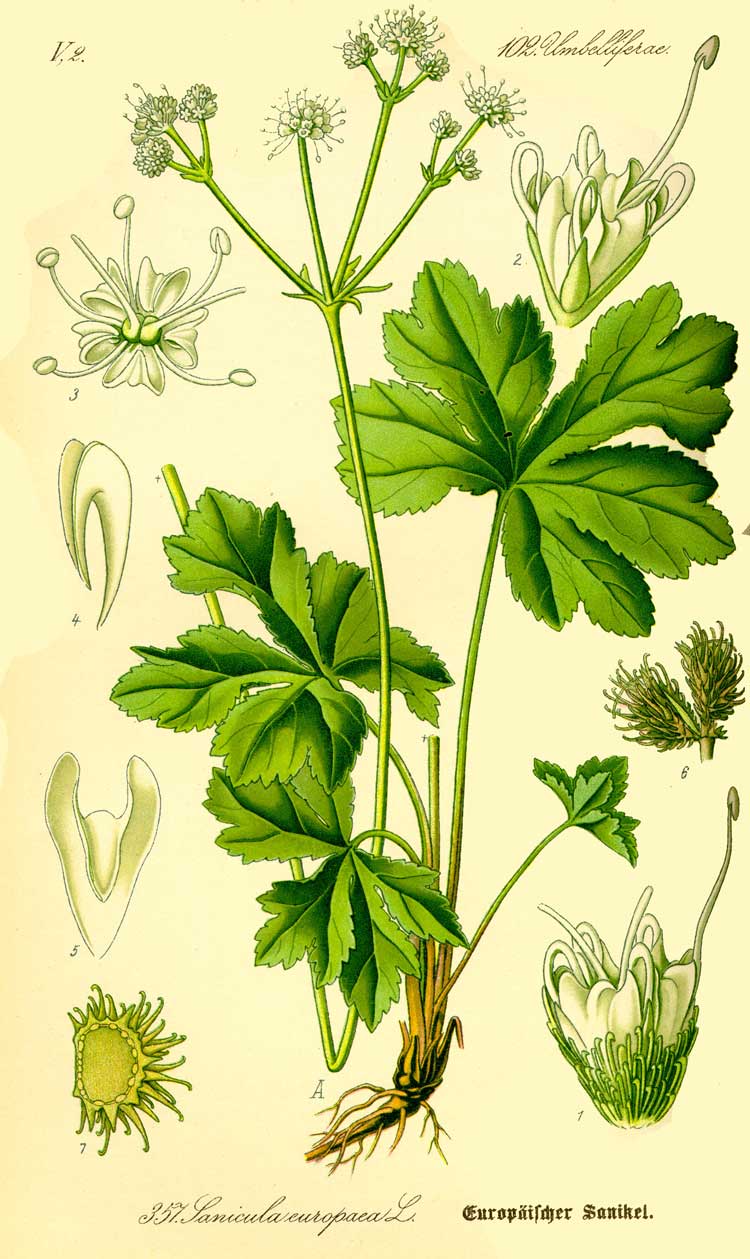
Sanicula europaea (*)
Classification System: APG IV
Superregnum: Eukaryota
Regnum: Plantae
Cladus: Angiosperms
Cladus: Eudicots
Cladus: Core eudicots
Cladus: Asterids
Cladus: Campanulids
Ordo: Apiales
Familia: Apiaceae
Subfamilia: Saniculoideae
Tribus: Saniculeae
Genus: Sanicula
Species: Sanicula europaea
Name
Sanicula europaea L., Sp. Pl.: 235 (1753).
Synonyms
Astrantia diapensia Scop.
Caucalis capitata Stokes
Caucalis sanicula Crantz
Sanicula officinalis Gouan
Sanicula officinarum Neck.
Sanicula sylvatica Salisb.
Sanicula trilobata Gilib.
Sanicula vulgaris Fries
Distribution
Native distribution areas:
References
Linnaeus, C. 1753. Species Plantarum. Tomus I: 235. Reference page.
Links
Hassler, M. 2018. Sanicula europaea. World Plants: Synonymic Checklists of the Vascular Plants of the World In: Roskovh, Y., Abucay, L., Orrell, T., Nicolson, D., Bailly, N., Kirk, P., Bourgoin, T., DeWalt, R.E., Decock, W., De Wever, A., Nieukerken, E. van, Zarucchi, J. & Penev, L., eds. 2018. Species 2000 & ITIS Catalogue of Life. Published on the internet. Accessed: 2018 Sept. 17. Reference page.
International Plant Names Index. 2018. Sanicula europaea. Published online. Accessed: Sept. 17 2018.
The Plant List 2013. Sanicula europaea in The Plant List Version 1.1. Published on the internet. Accessed: 2018 Sept. 17.
Tropicos.org 2018. Sanicula europaea. Missouri Botanical Garden. Published on the internet. Accessed: 2018 Sept. 17.
USDA, ARS, Germplasm Resources Information Network. Sanicula europaea in the Germplasm Resources Information Network (GRIN), U.S. Department of Agriculture Agricultural Research Service. Accessed: 07-Oct-06.
Vernacular names
العربية: سانيكولة اوروبية
български: дебрянка
čeština: žindava evropská
Cymraeg: Clust yr arth
dansk: Sanikel
Deutsch: Wald-Sanikel
English: Wood sanicle
español: Sanícula
euskara: Ositxeka
فارسی: سنیکولا اروپاییا
suomi: Haavayrtti
français: Sanicle d'Europe
Gaelg: Bossan keylley
hornjoserbsce: Lěsna hojawa
magyar: Gombernyő
Nederlands: Heelkruid
norsk nynorsk: Sanikel
polski: źankiel zwyczajny
русский: Подлесник европейский
slovenčina: žindava európska
svenska: Sårläka
Türkçe: Derman otu
українська: Підлісник європейський
中文: 软雀花
Sanicula europaea, the sanicle or wood sanicle, is a perennial plant of the family Apiaceae.
It has traditionally been a favoured ingredient of many herbal remedies, and of it was said "he who has sanicle and self-heal needs neither physician nor surgeon".[1][2]: 342
Description
Sanicula europea L. grows to 60 cm high and is glabrous with coarsely toothed leaves.[3] The pinkish flowers are borne in tight spherical umbels and are followed by bristly fruits which easily attach to clothing or animal fur and are thus easily distributed. The leaves are lobed and glossy, dark green.
Habitat
It is widespread in shady places[4] in woodland across Europe.
Etymology
Sanicula comes from sanus, Latin for "healthy", reflecting its use in traditional remedies.[5]
Uses
Sanicula europaea was used in Europe for healing wounds and cleaning.[6][5] Filtered leaf extracts of sanicula europaea have shown some antiviral properties, inhibiting the replication of type 2 Human parainfluenza viruses (HPIV-2).[7]
Infusions of sanicle, made with water or wine, were commonly used in France to cure dysentery, ulcers and kidney injuries.[8] To this list Culpeper added that sanicle heals tumours in any part of the body, and alleviates gonorrhoea, bowel pain and more.[2]
The roots have been used in the traditional Austrian medicine internally (as tea) or externally (as ointment) for treatment of disorders of the skin, respiratory tract, locomotor system, gastrointestinal tract, and infections.[9]
References
Jacob, John (1836). West Devon and Cornwall Flora. Devonport: Longman, Rees, Orme, Brown, Green, & Longman.
Culpeper, Nicholas (1858). Culpeper's Complete Herbal. Halifax: Milner and Sowerby. p. 331.
Clapham, A.R., Tutin, T.G. and Warburg, E.F. 1968. Excursion Flora of the British Isles. Cambridge University Press. ISBN 0 521 04656 4[page needed]
Webb, D,A., Parnell, J. and Doogue, D. 1996. An Irish Flora Dundalgan Press Ltd. Dundalk. ISBN 0-85221-131-7[page needed]
America, Garden Club of (1933). "Garden Club of America". Bulletin: 10.
Redwood, Theophilus (1848). Gray's Supplement to the Pharmacopoeia. London: Longman and co. p. 315. "Sanicula europaea."
Karagöz, A; Arda, N; Gören, N; Nagata, K; Kuru, A (August 1999). "Antiviral activity of Sanicula europaea L. extracts on multiplication of human parainfluenza virus type 2". Phytotherapy Research. 13 (5): 436–8. doi:10.1002/(sici)1099-1573(199908/09)13:5<436::aid-ptr459>3.0.co;2-q. PMID 10441789.
Dodoens, Rembert (1557). Histoire des plantes, en laquelle est contenue l'histoire entière des herbes... (in French). Anvers: Jean Loë. p. 106.
Vogl, Sylvia; Picker, Paolo; Mihaly-Bison, Judit; Fakhrudin, Nanang; Atanasov, Atanas G.; Heiss, Elke H.; Wawrosch, Christoph; Reznicek, Gottfried; Dirsch, Verena M.; Saukel, Johannes; Kopp, Brigitte (2013). "Ethnopharmacological in vitro studies on Austria's folk medicine—An unexplored lore in vitro anti-inflammatory activities of 71 Austrian traditional herbal drugs". Journal of Ethnopharmacology. 149 (3): 750–71. doi:10.1016/j.jep.2013.06.007. PMC 3791396. PMID 23770053.
Retrieved from "http://en.wikipedia.org/"
All text is available under the terms of the GNU Free Documentation License

